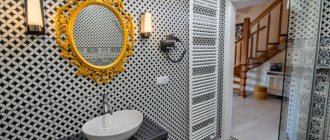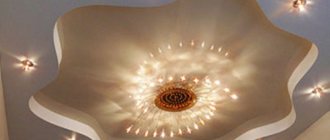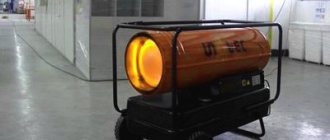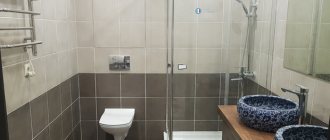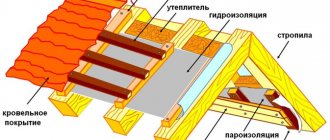Today, the thermal curtain is already a fairly common and popular heating device in many shops, garages, service stations, office buildings and other premises.
If you decide to install such a device, but have not yet decided which model to choose, let’s take a closer look at all the questions about the varieties and characteristics of individual types.
We will find out why they are needed in the first place and at the end we will list the main mistakes that you should avoid when purchasing and installing this unit.
What is it and what is it for?
Heat curtains are one of the types of heaters that operate on the principle of a fan. Externally, the device looks like a household air conditioner:
- has the shape of an elongated rectangle;
- There are holes on the top and bottom panels of the case to create air flow;
- metal body.
The unit differs from heaters in that they increase the air temperature in the room. This is their only task. The thermal curtain has two of them:
- cut off the path of cold air directed from the street into the apartment (main function);
- act as a heat source (secondary function).
The use of a thermal curtain for the entrance door allows you to save on heating the room during the cold season. Experts report that with the help of this device, electricity costs are reduced by more than a third. The savings are due to the absence of the need to connect other heat sources.
Thermal curtains belong to the category of semi-industrial heaters, so most devices have a discreet design and laconic forms. But the leading producers of this equipment understand that such devices do not always fit harmoniously into the interior of modern city apartments. And they offer consumers designer models that have a more attractive appearance. The front panel of such devices is made of impact-resistant glass in black or white.
What is the point of installing such a device?
A thermal curtain is a device that is installed in the area of the entrance door or gate and creates an air flow parallel to the doorway. Thanks to this, cold masses coming into the room from outside are cut off. If the air stream is heated inside the device, it serves as a more effective barrier to the cool outdoor climate.
Expert opinion Pavel Maksimovich Torsunov Even without heating, the air flow from the curtain creates a barrier to the movement of heat and cold. And in the summer, a curtain with the heating element turned off can cut off dust and small insects and keep out the heat, that is, work in the opposite way.
Design and principle of operation
All thermal curtains are designed and operate on the same principle.
All types of thermal curtains are designed according to the same principle
- Air is drawn in through the holes on the top panel.
- Inside the case there is a fan responsible for creating air flow in the top-to-bottom direction.
- Next to the fan is a heat exchanger that heats the air passing through it.
- Some models may have a filter.
- At the bottom of the case there are openings that supply a powerful air flow.
Cold air passes through the heat exchanger and a warm air stream is formed at the outlet
The devices are equipped with two types of blower fans:
- radial (compact and lightweight);
- tangential (have an elongated shape).
The device is controlled using buttons on the front panel or remote unit, as well as using the remote control. The device can be equipped with an air temperature control sensor. Most models are equipped with a power cable for connecting to the mains. But there are devices on the body of which only a terminal block is installed.
Water curtains
These varieties are connected to a common water heating system. The coolant circulating through the heater gives off its thermal energy to the air that passes through it.
Advantages:
- significant energy savings
For their operation, voltage is required only for the fan. No powerful heating elements.
Although they are much more expensive, with frequent use, such devices recoup their costs in the first season.
- high thermal power
They are installed in large industrial and warehouse premises.
Flaws:
- complexity of installation and maintenance
- It’s not uncommon for tubes to become clogged and circulation to stop
- high price
Advantages and disadvantages
Installing a thermal curtain over the front door has a number of advantages. The main advantage is to increase the level of comfort of living in the apartment. This is ensured by several effects:
- protection from outside penetration of dust, odors, smog;
- eliminating drafts;
- protection against penetration of flying insects;
- eliminating the leakage of air cooled by air conditioning from the room;
- maintaining a stable temperature inside the apartment.
No disadvantages of using thermal curtains were found. Equipment in this segment of heat fans is not an essential item, but its installation significantly improves the quality of life.
Design
The thermal curtain most often has an elongated shape. The body is made of thin-walled metal or plastic. There are two groups of holes in the housing: through one, air is sucked into the device from the room, and through the other it comes out. A continuous flow of air flowing through the body of the device is provided by a drum-type fan - the same as in air conditioners.
A heating element is located immediately behind the entrance grille. Thanks to it, the air is heated to the desired temperature. The operation of the thermal curtain is regulated by a control unit - fully electronic or electronic-mechanical. Some devices have a remote control function via an infrared signal or radio.
How to choose a thermal curtain by type
Equipment in this segment is classified according to several criteria:
- type of installation;
- location relative to the doorway;
- type of heat exchanger and its presence.
Classification by type of installation
Based on the type of installation, there are two types of models:
- built-in;
- mounted
Devices of the first type are needed where attachments are inappropriate or do not fit into the design of the room. Built-in models will help out in situations where the height of the lintel above the front door does not allow the installation of attachments.
Devices of the second type are the most commonly used in city apartments and private houses. They are installed on a wall or ceiling using brackets, take up little space and do not interfere with entry and exit.
Classification by location
Based on the type of location, there are several types of thermal curtains:
- horizontal;
- vertical;
- universal.
The most popular and convenient devices are the first type: horizontal. They are installed directly above the doorway and supply air flow from top to bottom. Installation is carried out in two ways:
- using brackets;
- on fastening connections.
Horizontal models can be installed on both sides of the opening, but such installation is unreasonable for city apartments. It is used to cut off cold air at the entrances to public places.
Vertical ones have more compact dimensions than horizontal ones. This is due to the peculiarity of their installation: on the right or left side of the door. It is permissible to install equipment whose height does not exceed 1/3 of the opening height.
Universal models can be installed in any position of the housing: vertical or horizontal. The mobility of such curtains has led to a higher demand for them than for other types of devices. Universal equipment is in demand in administrative buildings, city apartments and private houses.
Classification by type and presence of heat exchanger
According to this criterion, three types of curtains are distinguished:
- electrical;
- water;
- without heat exchanger.
Electrical
The most popular category of thermal curtains. Equipment of this type operates on a 220 V mains voltage and is lightweight and simple to operate. Serial marking:
- RS;
- R.M.;
- RT.
Most models of this type are equipped with a temperature controller. This is a justified decision, since the energy consumption of the curtains is quite high. When it gets warmer outside, you can adjust the device so that it produces cool air. A distinctive feature of this type of equipment is its inertia. In order for the device to reach operating mode, it needs some time, since the heat exchanger must heat up. For more powerful devices this process occurs faster.
The first models of thermal curtains used spiral heat exchangers. They have many disadvantages, the main ones being the “burning” of oxygen and dehumidification of the air in the room. Over time, most manufacturers abandoned this type of heat exchangers and in modern air curtains they install tubular or air-conductor ones. Such models always have a heating control function.
Mermen
Equipment of this type (serial marking RW) has lower power consumption, since they only need electricity to operate the fan and control system. In these models, the coolant that heats the air flow is hot water. In this regard, installation of equipment is complicated.
Water-type thermal curtains consume less electricity
The heat exchanger consists of thin pipes and resembles a car radiator. The water circuit is connected to the water supply through pipes located on the side panels of the device. It is also necessary to install a pipeline leading to the water intake point. The connection can be made to a heating or hot water system.
The second option is preferable because if the heating is turned off, heating will not be possible. But this is not a reason for disappointment, since the heating is turned off when the average daily temperature is positive and there is no need to heat the room.
Installation of a water heat curtain is also complicated by the fact that it requires an additional branch from the general circuit of the utility network. It must be provided for at the installation stage of the water supply distribution. Subsequently, it will be impossible to connect the equipment without damaging the external decoration of the premises.
An important design element of the device is a filter that retains sand and other impurities in the water. Since its quality often leaves much to be desired, regular filter cleaning will be required.
Without heat exchanger
Serial marking of air curtains without a heat exchanger is RV. Equipment of this type performs only one function - cutting off air masses located behind the front door. But at the same time it protects the interior space from smog.
Heat guns are also used as an additional heat source. Review of models in our next material:
Rating of the best manufacturers of thermal curtains, review of models
Ordinary consumers of this product segment do not always agree with the recommendations of experts. To help you choose the most suitable model, we present to your attention a rating of popular thermal curtains based on real user reviews.
Budget models
| Model | Characteristics |
| Ballu BHC-L06-S03 This model is intended for installation in doorways of apartments, private houses, technical and utility rooms, garages and outbuildings as a heater and energy-saving element. The power of the device is 3 kW. Productivity - 350 m3/hour. The recommended height of horizontal installation is 2.5 m. Equipment: two-stage power adjustment 1.5/3 kW, ventilation function without heating. The price varies from 3.5 to 5 thousand rubles. Advantages:
Flaws:
| |
| Tropic K 6 A popular domestically produced model, which is perfect for installation on standard window openings in private houses and apartments. Installation type: horizontal. Installation options: wall, floor. Power - 6 kW. Productivity - 350 m3/hour. Recommended installation height is up to 2.2 m. Equipment: two-stage power adjustment 3/6 kW. Can work in ventilation mode. The average cost is 6,000 rubles. Advantages:
Disadvantages: no remote control. | |
| Dantex RZ-0609 DDN An excellent, inexpensive and high-performance model designed for installation on the front door. Power - 6 kW. Productivity - 800 m3/hour. Features: metal impellers are used in the turbine design. Equipment: ceramic heating element (Positive Temperature Coefficient), overheating protection, multi-stage flow rate adjustment, remote control. The average cost is 8,000 rubles. Advantages:
No deficiencies found. |
Middle price segment
| Model | Characteristics |
| Frico AD105 Compact and lightweight model, designed for installation above window openings in small retail outlets, pavilions, offices, shops, etc. Power - 4.5 kW. Productivity - 500 m3/hour. Equipment: thermostat, power and flow rate regulator, overheating protection. The noise level does not exceed 50 dB. Features: possibility of installation in a suspended ceiling space. The average cost is 15,000 rubles. Advantages:
The disadvantage is the narrowly focused scope of application. | |
| CLASSIC KS-1003 According to reviews, this model reduces heat loss by up to 80% and ensures the maintenance of a comfortable indoor microclimate. Power - 3 kW. Productivity - 1350 m3/hour. Width - 985 mm. Installation height - 2.5 m. Installation type - horizontal. Equipment: thermostat, power and flow rate regulator, overheating protection, remote control. Features: heating elements with stainless steel fins are used as heating elements. The average cost is 18 thousand rubles. Advantages:
The disadvantage is the high cost of the device. | |
| Ballu BHC-18.500TR A powerful and efficient curtain designed for installation above openings up to 2 m wide and up to 5 m high. The scope of application of this model is extensive: gates of production workshops, hangars, warehouses, terminals, garage complexes, depots, exhibition halls, etc. Power: 20 kW. Productivity - 4000 m3/hour. Installation type: vertical/horizontal. Equipment: thermostat, overheating protection, heating power control, ventilation mode without heating. The average cost is 25,000 rubles. Advantages:
No deficiencies were identified. |
Premium models
| Model | Characteristics |
| Ballu-Machine (PS) BHC-H20T36-PS This model is designed to create an air barrier that prevents street air from entering the room. The product is installed in rooms with opening heights of up to 4.5 meters. Power - 36 kW. Productivity - 5000 m3/hour. Equipment: stepwise adjustment of power and air flow speed, remote control, thermostat. Installation type: universal. Features: spiral fin heating element, external rotor electric motor, solid nozzle. The average cost is 36 thousand rubles. Advantages:
Flaws:
| |
| Artos BARRIER 1500 This model is characterized by high reliability, quality and excellent technical characteristics, allowing installation in industrial, warehouse and retail premises. Power - 0.54 kW, productivity - 9000 m3/hour. Installation height - 6 m. Installation method: vertical/horizontal. Features: the model is equipped with adjustable blinds that allow you to change the direction of air flow. The average cost is 45,000 rubles. Advantages:
The disadvantage is the high cost of the device. | |
| Frico AD-215A High-performance air curtain without heating function is designed for horizontal installation in domestic and industrial premises. Installation type - above doorways, up to 2.5 m high. Capacity - 2100 m3/hour. Features: Thermozone technology allows you to create a low-turbulent air flow with a minimum noise level (43 dB), the ability to install in a suspended ceiling, the ability to adjust the speed and direction of the air flow. The average cost is 65,000 rubles. Advantages:
The disadvantage is the high cost of the device. |
Criteria for choosing a thermal curtain for an apartment
When choosing a thermal curtain, the first thing you need to pay attention to is power or air flow. Equipment with a low pumping rate is not able to cut off drafts and odors, while equipment with excessively high power causes a feeling of discomfort and heats not only the room, but also the street.
Based on performance, all thermal curtains are divided into three categories:
- low pressure;
- medium pressure;
- high-pressure.
Air curtains of the RS series are low-power, with a capacity of no more than 500 m³/hour. These are inexpensive models that are installed in openings no more than 150 cm high and up to 80 cm wide. They are not suitable for installation above the front door in apartments and houses. This requires medium-power models, the RM series.
These devices are installed in openings with a height of 200–300 cm. The equipment productivity is 1,500–2,000 m³/hour. Most manufacturers of thermal curtains of this series equip their products with remote units, which are installed in any place convenient for the owners. The equipment is controlled not only with the help of these units, but also with the help of remote controls (remote controls).
RT series devices are characterized by high productivity: more than 2500 m³/hour.
If equipment is chosen as the main source of heating the room, you will need a device with a power of 40 W/m³ of heated space. To provide additional heating, a device with a power of 20 W/m³ is sufficient. If the space in the apartment is wide, you can install several devices in a row.
One of the most important parameters is the length of the device. It should match the width of the doorway or overlap it. Otherwise, there will inevitably be gaps through which cold air will flow. The retail chain offers models with a length of 60–200 cm. For standard openings in apartments and private houses, equipment with a length of 80 cm is purchased.
Which air curtain is the best? Overview of additional options
The general principle of operation of air and thermal curtains is always the same, and the effectiveness of a particular solution is determined by technical or functional parameters. In particular:
- Installation method : as standard, the air curtain is mounted on the wall, because this solution ensures ideal air flow. However, if there are conditions for this, and the curtain manufacturer has provided this possibility, it can also be installed on the ceiling. True, in this case it is necessary to take into account the need to ensure a sufficiently large air supply to the device;
- Expansion of fan operation : this is especially important if you choose an electric curtain, because in them for a short time, after turning off the heater, it still remains warm, and the moment of fan operation allows the heater to cool effectively and, at the same time, make maximum use of the generated thermal energy ;
- Adjustability : Here we are talking about whether the curtain changes its power when opening or closing the entrance door. Some models are designed to be installed in combination with automatic opening doors or other means of automatically adjusting operating parameters when the door is opened. This is an important parameter that needs to be taken into account, since such models of curtains start at full power only when the door is open, having previously idled. Sometimes you can extend the working time of the curtain by several tens of seconds, even after closing the door, which will allow you to effectively warm up the amount of air that gets inside the house from the street;
- Ability to set the angle of attack : essentially this is the angle at which the air from the curtain will blow. This parameter is usually not paid attention to, but in vain. It is better to select thermal curtains for the house with such an angle of attack that they effectively heat not only the area near the door, but also other parts of the dressing room. Of course, sometimes it is practically impossible to calculate such values - in this case, it is recommended to choose an air curtain with an adjustable angle. To do this, you must use a special mounting bracket;
- Power control : air and heat curtains are designed to increase the comfort of living in the house and rid the rooms of the house of excess cold and moisture. Of course, most hovering models work fully automatically and we don’t have to tweak or change anything in them. However, all other things being equal, it is better to buy a thermal curtain that has several operating power settings;
- Protection : the curtains always come with a thermostat as standard. He is responsible for ensuring that the device only works when it is really necessary. The second protective element is the thermal fuse. It turns off the curtain in case of overheating so that the most important elements of the device are not damaged.
Did you find this article helpful? Please share it on social networks: Don't forget to bookmark the Nedvio website. We talk about construction, renovation, and country real estate in an interesting, useful and understandable way.
Installation of a thermal curtain on the entrance door
In most cases, for the improvement of apartments, thermal curtains are purchased that operate on electricity and with a tubular or strip heat exchanger. It is easier to install such equipment than an air conditioner. But despite this, manufacturers insist that installation be carried out by specialists. However, any owner who knows how to drill walls and screw in self-tapping screws will be able to install a thermal curtain with his own hands.
You can install the thermal curtain yourself
- Selecting an installation location. The device can be mounted directly above the opening, fixing it on the wall or ceiling.
- Marking. In accordance with the dimensions of the equipment, marks are made on the wall or ceiling. Installation is carried out through mounting holes in the housing. All models are equipped with a mounting panel, brackets or other fasteners. In the location chosen for installing the air curtain, mark the fastening points.
- Installation of brackets. Using a drill and a drill, holes are made in the right places. The brackets are secured with dowel nails.
- Installation of equipment. Hang the device on the brackets.
- Installation of the control unit. On most models, to access the terminal blocks, power cable and remote control cable, you must remove the front panel. It is secured with 8 self-tapping screws. After which the cables are secured in the housing using clamps or seals (most often these auxiliary elements are not included in the package).
- Connect both cables to the terminal blocks, focusing on the markings.
- Install the front panel.
- Connect the curtain to the electrical network.
For equipment with remote control, installation of the unit is required, which is carried out in several stages.
- Unscrew the 4 screws and remove the front cover.
- Drill holes in the wall.
- Attach the housing to the wall.
- Install the front cover.
During installation, it is important not to touch the electric motor, as there is a risk of disturbing the alignment of its shaft and impeller. This can lead to noise and vibration during operation of the air curtain.
Video: Review of the Ballu thermal curtain
Classification
The water thermal curtain can be presented in various models intended for use in buildings with certain conditions. Equipment is classified according to various characteristics, including:
- by purpose: general, for car washes;
- by air flow: small, medium, large;
- by location: vertical, horizontal;
- according to geometric parameters: according to the cross-section of the body - round, elliptical, rectangular, others; The structure of the nozzles is semicircular and straight.
Thermal power
If the room is equipped with sufficient heating, then you can choose a curtain model with no heating function.
Often, devices with a power of 6 to 12 kW are installed for standard door openings, but in practice it turns out that a less powerful device is sufficient for these places.
It is important that the consumption of the device matches the capabilities of the premises network. Particular attention should be paid to the technical characteristics of the network and equipment in the case when the curtain is used as additional heating.
Control methods
Monitoring and control of the operation of thermal protective devices can be carried out manually and automatically. Basic management methods:
- Turn the device on or off. Automation, synchronized with door opening, saves money and the air curtain's lifespan. The protective flow is activated only when the doors are open.
- Air flow temperature control. In simple devices it is carried out using a manual temperature switch. In expensive devices, the degree of heating is adjusted depending on the outside temperature. In hot weather, the heating elements can be turned off, and the curtain ensures that the room remains cool.
- Remote control of operating modes is carried out using a portable remote control.

